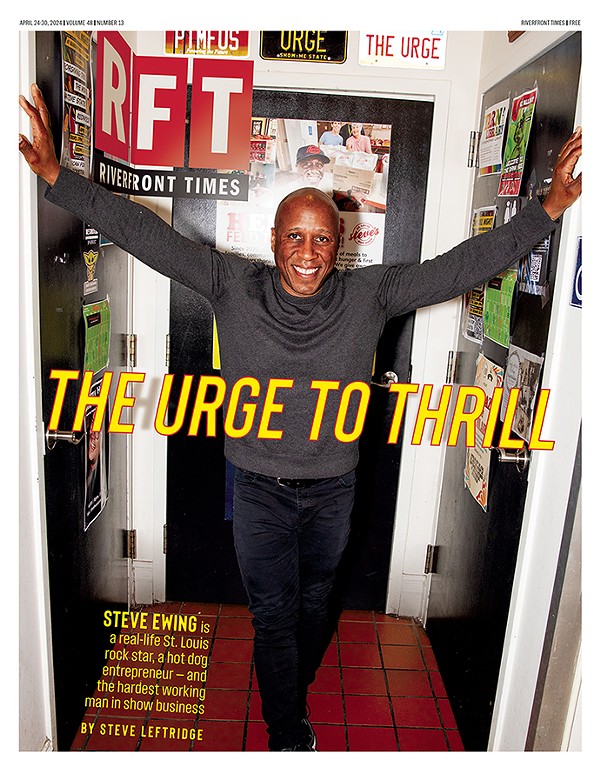Forty-plus years ago, if there had been a prefabricated, national-trend-monitoring, consultant-programmed, tightly formatted radio station called "Extreme," things would have been different. The artists on this station would have included the likes of Jerry Lee Lewis, Eddie Cochran, the Johnny Burnette Trio, Little Richard, Chuck Berry, Elvis Presley, Larry Williams and Bo Diddley. They were the extremists of their day, working without any idea what would happen next. They were, as the title of a new box set implies, Loud, Fast & Out of Control (Rhino).
Popular music changed drastically in the United States during the 1950s. There had been groundwork laid for decades, with elements of jazz, pop, hillbilly and rhythm & blues bouncing off each other from time to time. But with that first great rock & roll explosion, these forms were permanently merged into something entirely different. Rock & roll didn't replace any of its progenitors; it simply joined them, and crowded them out and into smaller shares of the marketplace. At first, rock & roll seemed capable of uniting the country, or at least our youngest denizens, across racial, ethnic and class lines. One reason there couldn't have been an "Extreme" radio back then was that radio was reacting quickly to changing tastes, trying to reach a mass audience that didn't see any contradiction in Elvis Presley topping Billboard charts in pop, R&B and country categories. And, though you wouldn't know it from this box, he could do this singing a frantic, aggressive rock song or a ballad.
By now, consumers are familiar with the box-set sections in record stores. Hun-continued on page 67PICKcontinued from page 64dreds of them have been issued, and most of them are simply expanded greatest-hits volumes or complete collections of work from one record label or another. The goal of making an artistic statement with a box set has been nearly forgotten. Loud, Fast & Out of Control, however, wants to tell a story and to reinvigorate the music contained within. The idea here is to postulate '50s rock & roll, which has been forgotten as even oldies radio stations dropped it from their formats, as something similar to the music that today's kids are using to scare today's parents.
The exclusive programming of wild, energetic, fast rock & roll makes for an exhilarating aesthetic experience. However, the box overlooks crucial differences between what's on "Extreme" and what's heard here. The music in this box set does contain seeds of what came later. Rock & roll made song forms more elastic by simplifying their structure. Again and again, whenever rock has needed to be invigorated, somebody returns to the roots, strips down songs into the most basic chords and finds the power in a lack of complexity. Even more obvious, rock & roll codified a basic rule that has never been abandoned since: Energy trumps smoothness. The songs on this box may not sound as thick and frenzied as modern rock does, but a teenager today would still be able to identify the difference between Little Richard and Pat Boone.
Actually, there's more to that difference that is important, which leads to a significant problem with the box set's thesis. Context is crucial. These records sounded dangerous in the 1950s partly because they were heard side by side with Boone, Dean Martin or Doris Day and because they broke all the rules of the day. To hear Pat Boone cover "Tutti Frutti" is inherently laughable, because try as he might to be a part of that culture, Boone was completely outside it. Today, with 45 years of rock history breaking off into a thick shrubbery of subgenre branches, the differences between one or the other are harder to discern. If an " Extreme" artist covers a song by even a classic-rock artist, as when Metallica sings Bob Seger, nothing sounds all that out of place.
Starting with punk rock, and reaching a peak with the alternative ascension of Nirvana, most popular rock music focused on anger. Anger was not a big part of the rock & roll of the '50s. The story made most clear listening to this box is one of immersion in the unbridled hormonal rush of adolescence, searching for beauty by pushing the limits of speed and power. These artists were expressing what hadn't been expressed, laughing at what seemed so obviously false and striving to reach a promised land of new possibility. If there is one absolute difference between rock & roll of the '50s and rock in the '90s, it is that rock & roll believed things would get better whereas rock now believes things will most likely get worse.
The civil-rights movement started about the same time rock & roll became culturally significant, as both Michael Ventura and Billy Vera point out in their well-written liner notes. People started to believe that the refusal to treat people of different races as one was about to end. Older people were often scared by this. Younger people heard the freedom of rock & roll as a clarion call that change was worth pursuing. Toss in a little rebellion across class lines, as rock & roll became a path from ghetto or farm to mansion and millionaire status, and a whole lot of newly uncloseted sexuality, and you've got a recipe for hope that has since faded away from the music. There's only so long you can sing of change for the better before the reality of change for the worse smacks you in the face.
Because equality of the races was never as simple to achieve as seemed hopeful at first, musical integration had to be squeezed off. The days of rock & roll records ruling all three big charts were quickly over. Rhythm & blues, soon gospelized as soul, and country & western, soon urbanized as simply country, infused themselves with rock & roll, then followed their own paths. The energy, sexuality and rhythmic charge of R&B was internalized into rock forever, but the Southernness of country was exorcised. Partly, this was inevitable, as rock artists started coming from all over the U.S. and England. But there was a reaction against country so strong that even today any attempt to dig up those roots results in a newly named hybrid of country-rock. Rock no longer enjoys the swagger of its country-raised practitioners, and if there's anything that would push today's youth away from Loud, Fast & Out of Control, the pervasiveness of Southern accents, twang and rhythms might be it.
The four CDs in this box set are crammed with magnificent songs. Some of them are familiar to almost everybody: "Maybelline" by Chuck Berry, "Blue Suede Shoes" by Carl Perkins, "Summertime Blues" by Eddie Cochran, "Whole Lot of Shakin' Goin' On" by Jerry Lee Lewis, "Who Do You Love" by Bo Diddley. Others are obscure, known only to the most fanatical collector: "Love Me" by the Phantom, "Number 9 Train" by Tarheel Slim, "Brand New Cadillac" by Vince Taylor (this song is much more familiar to Clash fans who memorized London Calling years ago). If, by chance, you know only a few songs here, and are partial to them, pick up the box and prepare to be blown away. If you do know many of them, you'll be pleased to hear them jump out at you with their original power intact, and in a pleasing presentation that neatly mixes and matches styles. Loud, Fast & Out of Control may try to do too much when it attempts to convince today's youth of their similarity to kids of the '50s. But it succeeds wildly at presenting rock & roll as a representation of freedom, fucking and the force of nature.





